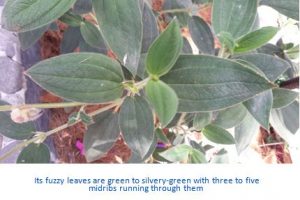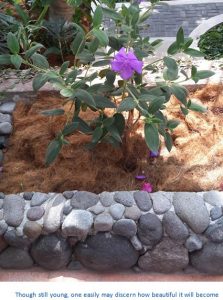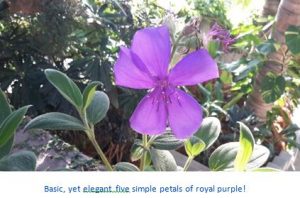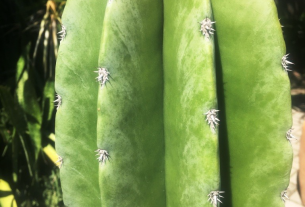By Tommy Clarkson from the April 2017 Edition
Princess Flower, Tibouchina urvilleana
Family: Melastomataceae
Also known as: Glory Bush, Glory Flower or Lasiandra
Ok, you’re correct. I should have recognized this Brazilian as a Princess Flower when I acquired it. But I didn’t. (So beat me with a healthy handful of Heliconias!) Hence, with a bit of egg (or was that pollen) on my face, I had to be reminded of its identity by Hans Meyer a botanically knowledgeable, and most enjoyable, recent visitor to our gardens!
 In his wonderful tome, The Tropical Look, Robert Lee Riffle correctly observed that, “This is yet another wonderful genus of plants whose members are lamentably mostly absent in horticulture. The genus is rife with wondrous species of greatly varying character and should be much more widely exploited for gardens in the tropics and sub-tropics.”
In his wonderful tome, The Tropical Look, Robert Lee Riffle correctly observed that, “This is yet another wonderful genus of plants whose members are lamentably mostly absent in horticulture. The genus is rife with wondrous species of greatly varying character and should be much more widely exploited for gardens in the tropics and sub-tropics.”
These beauties of the Tibochina genus comprise between 250 and 350 tropical American species of shrubs and small trees. Relative to these, I’ve read that the genus is being evaluated by the botanical gurus (whomever and wherever they are) for possible combination of presently described alternative species. Yet, additional secondary research on my part divulged that no few of the various named members of this genus share the (other) common designation of Glory Bush.
In some older botanical reference books, this plant is called T. semidecandra. But today, that’s merely a synonym along with T. grandiflora. The Royal Horticultural Society describes these plants in a bit more refined and botanically cultured manner than do I: “Tibouchina can be evergreen shrubs or herbaceous perennials, with simple, prominently veined leaves and saucer shaped flowers with conspicuous stamens. T. urvilleana (in particular) is a lax evergreen shrub to 4 meters or more, with elliptic, softly hairy leaves with prominent longitudinal veins and rich violet purple flowers 6-10cm across, with exserted, blackish stamens.” (For other country hicks like me, “exserterd” means “projecting beyond the surrounding parts”. (Perchance, like my sadly tubby belly?)
Her highness is seldom bothered by commoner plagues, pests, pestilence or diseases of the masses, is  easy to raise to adult- hood and requires but limited supervision and attention. (That’s my kind of plant! However, even healthy specimens can experience transplant stress when first moved from their “store bought” containers to a permanent outdoor home. Don’t you stress if they lose some leaves, become discolored and or cease to bloom for a bit. But, you can lessen their stress by providing ample water and some fertilizer at the time of transplanting.
easy to raise to adult- hood and requires but limited supervision and attention. (That’s my kind of plant! However, even healthy specimens can experience transplant stress when first moved from their “store bought” containers to a permanent outdoor home. Don’t you stress if they lose some leaves, become discolored and or cease to bloom for a bit. But, you can lessen their stress by providing ample water and some fertilizer at the time of transplanting.
Once your royal Princess Flower is happily ensconced in a location of full sun with protection from the wind, there are but three things to keep in mind: Proper drinks, grooming and dining Regarding the first, water thoroughly at least once a week keeping the soil around the plant moist, but not too wet, and heavily mulch its roots. As to that second need, following its blooming, remove dead, damaged, diseased limbs as well as those that grow toward the plant’s center trimmed as close as possible to the trunk. With its nice looking cinnamon bark, you may wish to prune it into a shrub by removal of leggy growth, while some others prefer to cut the bottom branches off for a more tree-like appearance. Concerning its nutrients, fertilize each spring and after each blooming cycle. An organic acidic fertilizer like those for azaleas and rhododendrons is best.
Now for my plant description: With several pink to royal-purple of its five obovate petaled flowers blooming throughout the year, this Brazilian native is a great addition to one’s tropical garden. Fuzzy on both sides, its obvate (generally short- stemmed) leaves are green to silvery green. These have three to five midribs running through their two to eight inches (5-20 cm) length. Sometimes these are tinged with red and lighter on the undersides. They adorn quadrangular, equally fuzzy, stems that potentially range in an ultimate height of eighteen to twenty feet (5.49-6.10 meters).
These good looking plants draw bees, butterflies and birds. As a result, we employ ours as a specimen plant on our Transition Terrace. However, it can well suit the purpose and function of other folks as a hedge. The Princess Flower prefers moist, fertile but well-draining soil in a sunny locale. As to living conditions, a Mediterranean climate (similar to that of coastal Southern California) suits it just fine.
Download the full edition or view it online
—
Tommy Clarkson is a bit of a renaissance man. He’s lived and worked in locales as disparate as the 1.2 square mile island of Kwajalein to war-torn Iraq, from aboard he and Patty’s boat berthed out of Sea Bright, NJ to Thailand, Germany, Hawaii and Viet Nam; He’s taught classes and courses on creative writing and mass communications from the elementary grades to graduate level; He’s spoken to a wide array of meetings, conferences and assemblages on topics as varied as Buddhism, strategic marketing and tropical plants; In the latter category he and Patty’s recently book, “The Civilized Jungle” – written for the lay gardener – has been heralded as “the best tropical plant book in the last ten years”; And, according to Trip Advisor, their spectacular tropical creation – Ola Brisa Gardens – is the “Number One Tour destination in Manzanillo”.




